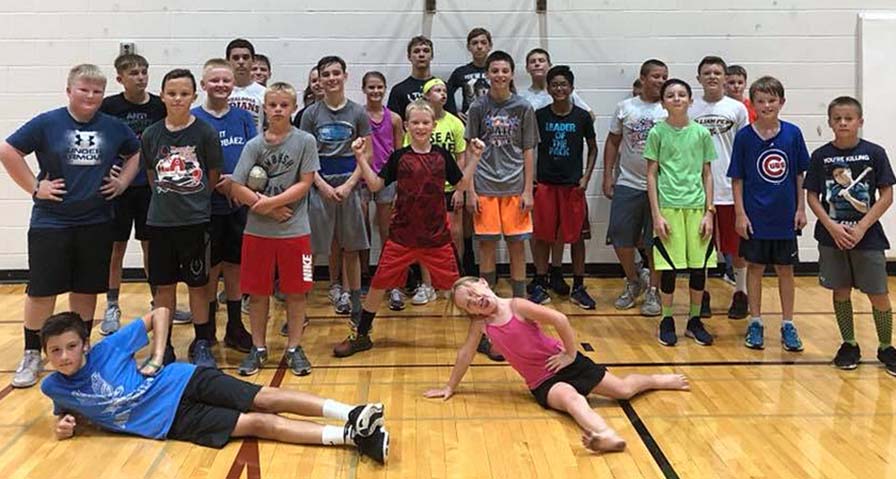Twenty-Minute Session Primes Students for Math and Literacy Blocks, Boosts Activity Time for Incoming Sixth-Graders
To remedy the activity gap between the sixth-graders and the older students at Oskaloosa (Iowa) Middle School, PE teacher Betsy Luck worked with colleagues and school leadership to develop a program to prepare students for their toughest classes with 20 minutes of physical activity every morning.
Luck spent part of her summer vacation studying the 15-minute mile principle published as part of “The Daily Mile,” a British program that encourages students to run or walk for at least a mile as a break in their academic day. After studying the program, Luck thought a similar program would work well at the start of her school’s day, for several reasons.
Three years ago, the Oskaloosa Community School District leadership revised the middle school schedules to address a decline in math and literacy assessment scores. Middle schoolers now start each day with two 90-minute blocks for their math and literacy classes. With her Daily Mile research, along with data provided by Illinois PE teacher Paul Zientarski that proves students who are active and physically fit are more academically alert, Luck wanted to give students every opportunity for success.
“We wanted to give them a huge jolt of oxygenated blood flowing through their systems before they go down (to their math and literacy blocks), and also as sixth graders, to get those jitterbugs out so they can go down there and focus,” Luck said. “They don’t have to run. We just want them out there and moving. They seem to enjoy it.”
Sending students to their most challenging classes with active minds is part of her thinking, based on volumes of research detailing the positive impact activity has on brain development. She also wanted to increase the amount of active time the sixth-graders got each week. Their schedule sends them to PE just once every four days.
“For us, we really don’t like being limited to every fourth day of activity for these kids, but now we’re doing it every day and seeing a big improvement,” she said.
Linking Activity to Physical Fitness and Academic Improvement
“This is the third year of the program where they have big blocks of math and literacy,” Luck said. “We’ve seen the scores start to come back a little bit so this has been a really positive thing.”
With her youngest students moving every day, Luck wants to see students’ fitness scores improve the same way the math and literacy scores have. Working with those teachers to collect data, Luck will use the IHT Spirit System to demonstrate the link between improved fitness and academics as the year progresses.
“I’m excited to get some data from the sixth-grade teachers and learn from that,” Luck said. “We want to see if they are able to focus better on their studies since we’ve been getting some exercise in beforehand. This is something that is easy to track once we get it going.”
Letting Students Reflect on Workout Choices to Build Healthy Habits
Two years ago, Luck introduced the flipped classroom model to her students, allowing them to lead the class and prove they understand key fitness concepts. “Flipped Wednesday” remains one of her program’s staples, teaching students to develop intrinsic skills reinforced by the IHT ZONE wrist heart rate monitors and IHT Spirit System.
“We’ve been doing our Flipped Wednesdays for several years now,” she said. “We set up multiple pieces of equipment and allow the kids to make a choice as to what they want to be involved in.”
Students choose their own workout with the caveat that they still have a goal – minutes spent exercising in the target heart rate zones – for each class.
“They can make all the choices in the world that they want to,” she said. “It’s up to them to create a workout that will help them reach their goal.”
Students can gauge their effort level by looking at the ZONE monitors throughout the class. They’ll see if they are in their target – yellow or red – heart rate zones and can adjust accordingly. After each class, the Spirit System delivers each student, and their parents, an email summarizing their individual workout. Students review the summary report and must submit their reflections on a number of key points:
- Did you reach your goal? If not, what can you do next time to reach your goal?
- What fitness component did the lesson feature?
- What level of the fitness pyramid were you on?
“We want them thinking about what they are doing on a daily basis and how often they should be doing those things,” Luck said.
The self-reflection helps reinforce lessons that Luck wants students to be able to take with them as they mature. Luck’s curriculum includes traditional sports skills but also relies heavily on today’s popular fitness trends including High-Intensity Interval Training and CrossFit.
“We want to give them the base vocabulary to understand what those workouts are and to set some of them up so they have the choice to decide how they are going to be active and get their exercise in,” she said.
Along with the terminology, Luck wants her students to make the most of the PE heart rate technology. Students wear the ZONE monitors in each PE class, and Luck uses them to help students focus on how they feel when the monitor shows them they’ve reached their target heart rate zone.
“We must teach them while they’re in middle school exactly what it takes to be in that yellow zone…what does it feel like?” she said. “How hard is your heart pumping? What do your legs feel like? How hard are you breathing? So when you don’t have that monitor on, you still know what your body should be feeling like to be in the appropriate level of activity.”
The ability to develop those intrinsic skills, Luck said, remains her primary goal for the students.
“That’s a big goal for us,” she said. “That life-long learning and being able to take this out into the real world if I’m a young adult. ‘I know what it should feel like when I do something so that it will help me out.’”



